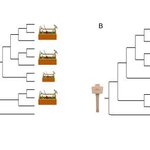Evolution

There was an idea first proposed in 1916 — that plants with rapid reproductive cycles evolve faster - and a team of Yale scientists writing in Science say they have confirmed it using 2008 computing power.
Long involved with the Tree of Life Web Project, which is attempting to reconstruct the “tree” representing the genealogical relationships of all species on Earth, Michael Donoghue, the G. Evelyn Hutchinson Professor of Ecology & Evolutionary Biology and Curator of Botany at Yale’s Peabody Museum of Natural History, has spearheaded the study of flowering plant evolution. In animals,…

Eye color and hair color play a role in human partner choice but visual stimuli can also determine mating preferences in the animal kingdom.
In many species, the male’s fortunes in the mating stakes are decided by a conspicuous breeding dress. A study of brightly coloured fish has now demonstrated that this has less to do with aesthetics than with the sensitivity of female eyes, which varies as a result of adaptation to the environment. Females more attuned to blue will choose a metallic blue mate, while those better able to see red will prefer a bright red male.
These mating preferences…

MicroRNAs, the tiny molecules that fine-tune gene expression, were first discovered in 1993, but it turns out they've been around for a billion years. Evidence published in Nature by scientists in the lab of Whitehead Institute for Biomedical Research Member and Howard Hughes Medical Institute investigator David Bartel provides a window into the early evolution of these key regulators, placing their origin within the earliest of animal lineages.
The research also suggests that microRNAs present early on have undergone extensive changes, which likely have altered their functions across…

There's a sex bias in evolution, according to an article in PLoS Genetics, and it's demonstrated by the fact that women have been more successful on average in passing their genes on to the next generation. "This is because a few males have fathered children with multiple females, which occurs at the expense of other less successful males", says Dr. Michael Hammer, ARL Division of Biotechnology at the University of Arizona.
The group has found DNA evidence that polygyny, the practice among males of siring children with multiple female partners at the same time or successively, has led to an…

Scientists have decoded the genome of the Pristionchus pacificus nematode and gained valuable insight into the evolution of parasitism.
In their work, the scientists have shown that the genome of the nematode consists of a surprisingly large number of genes, some of which have unexpected functions. These include a number of genes that are helpful in breaking down harmful substances and for survival in a strange habitat: the Pristionchus uses beetles as a hideout and as means of transport, and feeds on the fungi and bacteria that spread out on their carcasses once they have died. It thus…

Pregnancy is a biologically unusual situation where one organism lives and develops inside another that is genetically different.
Ordinarily, the immune system identifies and destroys the dissimilar tissue as if it were a parasite but in some early mammals changes 'turned down' the immune system, allowing the developing embryo to grow and thrive unchallenged by the maternal immune response.
Yale researchers npw say that the origin and evolution of the placenta and uterus in mammals is associated with evolutionary changes in a single regulatory protein.
Old (A) and new (B) models for the…

In 1970 the anthropologist Robert Ardrey published “The Social Contract, A Personal Inquiry into the Evolutionary Sources of Order and Disorder”. The theme of the book was that the modern concept of human equality is a myth, and impossible in any sexually reproducing species.
But this was not a glorification of the strong over the weak, Ardrey showed that in all societies at any level of the animal world, structures exist to protect the vulnerable, and that this is an evolutionary advantage as it protects diversity, diversity being essential for creativity.
Just a few years later in 1976…

Bats' ability to echolocate may have evolved more than once, according to research published this week by Queen Mary, University of London scientists.
Species of bat with the ability to echolocate do not all group together in the evolutionary tree of life - some are more related to their non-echolocating cousins, the fruit bats. This has raised the question of whether echolocation in bats has evolved more than once, or whether the fruit bats somehow lost their ability to echolocate.
Writing in the Proceedings of the National Academy of Sciences, Dr Stephen Rossiter from Queen Mary's School…

Subtle genetic changes that confer an evolutionary advantage upon a species, such as the dexterity characteristic of the human hand, while difficult to detect and even harder to reproduce in a model system, have nevertheless generated keen interest amongst evolutionary biologists.
In findings published in Science, researchers have uncovered a specifically human 13-nucelotide change concealed in the vast three-billion-letter landscape of the human genome. Their experiments reveal this stretch of DNA to be a recently evolved regulator of gee expression that, when introduced into a mouse embryo…

Yale molecular and evolutionary biologists in collaboration with Department of Energy scientists produced the full genome sequence of Trichoplax, one of nature's most primitive multicellular organisms, providing a new insight into the evolution of all higher animals.
The findings reported in Nature show that while Trichoplax has one of the smallest nuclear genomes found in a multi-cellular creature, it contains signature sequences for gene regulation found in more complex animals and humans. Further, it defines Trichoplax as a branching point of animal evolution.
Trichoplax. Photo Credit:…